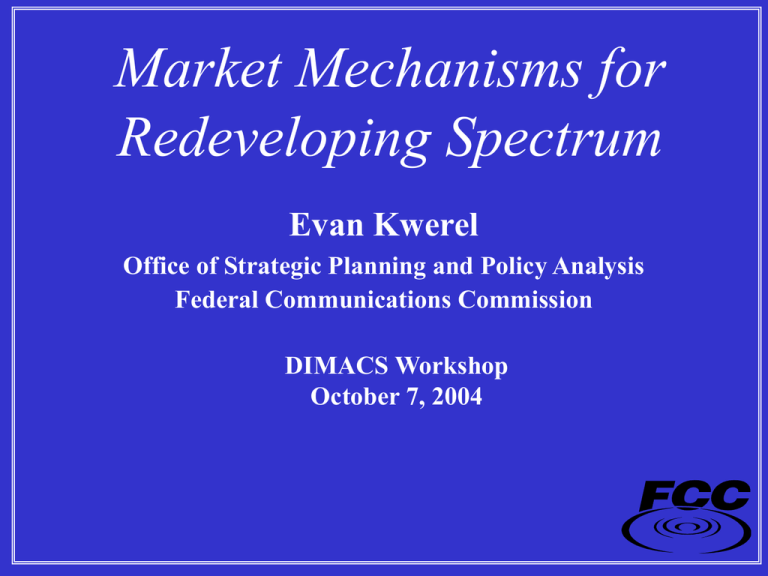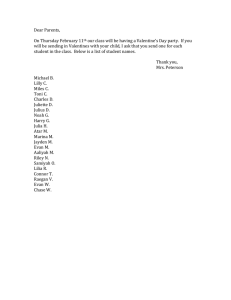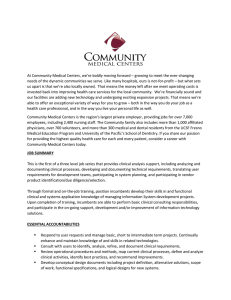Market Mechanisms for Redeveloping Spectrum
advertisement

Market Mechanisms for Redeveloping Spectrum Evan Kwerel Office of Strategic Planning and Policy Analysis Federal Communications Commission DIMACS Workshop October 7, 2004 Disclaimer • The opinions expressed in this talk are those of the author and do not necessarily represent the views of the FCC or any other members of its staff. • Talk is based on joint work with John Williams. Evan Kwerel 2 Only about 7% (185 MHz) of Spectrum in 300-3000 MHz Range Is Fully Available to Market Today PCS 3% Cellular 2% SMR 1% Cellular 50 MHz PCS 120 MHz SMR 15 MHz Other 2545 MHz Evan Kwerel 3 Another 15 % (413 MHz) for Flexible Use in the Pipeline From TV Channels 52-69 (78 MHz) 3% From MDS/ITFS (190 MHz) 6% From Gov't, MSS and others (145 MHz) 5% Evan Kwerel 4 But… • Heavily encumbered • Fragmented in geographic and frequency domains • Needs massive restructuring Evan Kwerel 5 TV and DTV Stations that Encumber Channel 67 in EAG-1 TV and DTV Stations on Channel 67 (Buffered) Service DT TV 68 66 6668 68 68 66 66 Northeas t EAG - 1 67 67 66 66 66 66 66 66 68 68 67 67 Great Lakes EAG - 4 67 67 67 67 68 68 68 68 Mid-Atlantic EAG - 2 68 68 April 18, 2000 Evan Kwerel 67 67 66 66 67 67 67 67 Federal Communications Commission Office of Engineering and Technology Melvin C. Del Rosario 6 TV Stations That Encumber Upper 700 MHz Spectrum (TV Channels 60-69) Within 100 miles of NYC 746 MHz 806 MHz TV Ch. 59 60 WBNE 62 PS 63 WRNNTV WBPHTV 64 782 C2 65 D2 66 67 WHSPTV WMBCTV WPPX 792 794 Guard Band D1 61 776 777 Guard Band C1 762 764 Guard Band Guard Band 747 752 PS 68 69 WHSETV WHSITV WEDY WFMZTV WTICTV WACI Notes: 1. Frequency range 746 MHz to 806 MHz contains TV channels 60-69 that have been reallocated for other uses subject to not causing interference to existing TV stations. 2. Arrows indicate frequency range encumbered because of potential co-channel or adjacent channel interference to the indicated TV station over some portion of the area within 100 miles of NYC. 3. Shaded rectangles on the upper bar graph are the two paired commercial spectrum blocks (10 MHz block C1/C2 and 20 MHz block D1/D2). 4. Blocks labeled “PS” are reserved for public safety use. 5. The “Guard Bands” comprise a total of 6 MHz in four bands designated for commercial use subject to special technical and operational restrictions to protect the public safety bands. Evan Kwerel John Williams Revised: 9/7/2004 7 How to End the Spectrum Drought • Property rights and markets – Define flexible, exclusive and exhaustive spectrum rights – Use markets to move spectrum to its highest value use • Big bang transition – All highly interdependent spectrum up for sale at the same time – Voluntary for incumbents but see opportunity cost – Incentives for incumbents to participate – Reduces transaction costs and increases liquidity – OSP WP 38 (www.fcc.gov/osp/workingp.html) Evan Kwerel 8 Alternative Big Bang Mechanisms • Auction that includes incumbents’ licenses. Incumbents can bid on their licenses at no net cost. • Auction where incumbents can get vouchers for turning back their licenses • Exchange where incumbents can offer licenses at declining ask prices Evan Kwerel 9 Mechanism 1: FCC Auction that Includes Incumbent Licenses • Simultaneously auction spectrum voluntarily offered by incumbents together with any unassigned spectrum. Use package bidding. • Participants – Get immediate flexibility – Can keep the proceeds from the sale of their licenses – Can buy back their licenses at no net cost – but can’t resell immediately • Non-participants – Do not receive full flexibility for significant time (e.g., 5 years) – Allowed to continue current operations Evan Kwerel 10 Mechanism 2: FCC Auction with Vouchers for Incumbents • Incumbents given auction vouchers in exchange for turning back their licenses • Value of vouchers determined in auction – Incumbents attributed spectrum quantities (MHzPops) based on licenses turned back – Voucher value = attributed MHz-Pops X auction prices/MHz-Pop of new licenses covering area of incumbent’s licenses Evan Kwerel 11 Mechanism 2: FCC Auction with Vouchers for Incumbents (cont’d) • Vouchers equivalent to cash – Can be used to pay winning bid in current or any subsequent auction – Transferable and divisible • Allows FCC to create new, fungible geographic area licenses suited to new uses – if mandatory or all incumbents participate voluntarily – No need to create licenses (geographic areas, frequencies) based on legacy rights – Bidders would bid on spectrum with certain characteristics (location, bandwidth, low power or high power), not specific frequencies, minimizing opportunity for destructive strategic behavior in auction Evan Kwerel 12 Mechanism 2: FCC Auction with Vouchers for Incumbents (cont’d) • Alternative design with “voluntary” participation – Allow incumbents to opt out and continue in current use. Opt-out spectrum limited to current use for significant period. – FCC can require non-participants to relocate to different part of auctioned band with costs paid from auction revenues or new licensees – Spectrum in cleared portion of band would be fungible in auction. Spectrum in relocation portion would not. Evan Kwerel 13 Mechanism 3: FCC Exchange • Incumbents can offer licenses at declining ask prices • David Parkes investigating alternative designs Evan Kwerel 14 Pros and Cons: Mechanism 1 • Pro: Incumbents can maintain status quo – “voluntary” • Pro: Uses “simple” one-sided auction mechanism • Con: FCC must define area licenses that approximate initial spectrum rights – Difficult, especially when encumbered areas overlap – May not be able to define usable area licenses based on incumbents rights for certain services, e.g. microwave – Allows bidding only on specific frequencies (not fungible rights). Evan Kwerel 15 Pros and Cons: Mechanism 2 • Pro: Allows FCC fresh start in defining and assigning spectrum rights – Clears entire band of incumbents – Can define new rights (geographic areas and frequency blocks) without regard to crazy-quilt pattern of legacy rights – Can design highly competitive auction for fungible spectrum rights – Minimizes strategic holdouts by incumbents to extent have liquid market for fungible rights • Pro: Uses “simple” one-sided auction mechanism • Con: Not voluntary, can’t maintain status quo Evan Kwerel 16 Pros and Cons: Mechanism 3 • Pro: Allows incumbents to offer licenses and bid for replacement licenses within single package • Con – Requires developing more complex exchange mechanism – FCC must define area licenses that approximate initial spectrum rights – If we make flexibility conditional on participation, how do we define participation? Evan Kwerel 17 Potential Applications • Accelerated clearing of TV spectrum (700 MHz band) • Restructuring airport landing/takeoff rights (slot auctions) Evan Kwerel 18 Remaining Issues • Best formula for dividing revenues among sellers (FCC and incumbents) – With package bidding no unique price for rights sold by incumbents – Equity – Efficiency of allocation – Incentives for participation in auction – Myerson and Satterthwaite (1983) impossibility theorem: budget balanced, efficient, voluntary Evan Kwerel 19 Thank you! Evan Kwerel Office of Strategic Planning and Policy Analysis Federal Communications Commission Evan.Kwerel@fcc.gov (202) 418-2045






